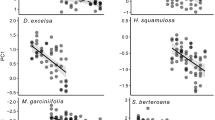Summary
Individual fibre lengths were measured on the projected images of macerated tissue samples of seven Eucalyptus species grown in a replicated species trial in Zambia. Analyses of variance and variance components were used to study variation between species, replications, distances from the pith, radial positions, microscope slides and individual fibres. The overall mean was 0.93 mm and little variation was attributable to the main factors (fixed effects); two-thircs of total variation was due to differences between fibres within samples. Variance components for random factors were used to compare different sampling strategies; the size of acceptable difference for hardwoods (0.10 ... 0.14 mm) is considerably less than that for conifers and samples of 80 ... 200 fibres may be necessary. Differences between microscope slides were unimportant and two or more slides would be necessary only to facilitate location of the large numbers of fibres or to provide a check on operators.
Similar content being viewed by others
References
Burley, J., Adlard, P. G., Waters, P. 1970. Variances of tracheid lengths in tropical pines from central Africa. Wood Sci. Technol. 4: 36–44
Chudnoff, M., Tischler, K. 1963. Fiber morphology of Eucalyptus camaldulensis Dehn. and the relation of wood anatomy to certain physical and mechanical properties. La-Yaaren; Suppl. (1): 23pp.
Forest Biology Subcommittee No. 2. 1966. Needs for improvement in methods for small sample measurement of wood and fiber properties. TAPPI 49 (2): 87A-91A.
Harris, J. M. 1966. A method of minimising bias in measuring tracheid length. Jour. Roy. Microscop. Soc. 86 (1): 81–83.
Hart, C. A., Swindel, B. F. 1967. Notes on the laboratory sampling of macerated wood fibers. TAPPI 50 (7): 379–381.
Ranatunga, M. S. 1964. A study of the fibre lengths of Eucalyptus grandis grown in Ceylon. Ceylon For. 6 (3/4): 101–112.
Rudman, P., Higgs, M., Davidson, J., Malajczuk, N. 1969. Breeding eucalypts for wood properties. Pap. submitted to FAO Second World Consultation on Forest Tree Breeding Washington. FO-FTB-69-4/7. 9pp.
Scaramuzzi, G. 1964. Wood fibre dimensions of some young Italian-grown eucalypts. Rep. and Docum. 2nd World Eucalyptus Conf., Sao Paulo 1961. 2: 1289–1294.
Stern-Cohen, S., Fahn, A. 1964. Structure and variation of the wood fibres of Eucalyptus gomphocephala A.D.C. along and across thestem. La-Yaaren 14(4): 106–117; 133–132.
Tamolang, F. N., Wangaard, F. F. 1961. Relationship between hardwood fiber characteristics and pulp-sheet properties. TAPPI 44 (3): 201–216.
Author information
Authors and Affiliations
Additional information
Laboratory work was carried out at Tree Improvement Research Centre, Kitwe, Zambia.
Rights and permissions
About this article
Cite this article
Burley, J., Posner, T. & Waters, P. Sampling techniques for measurement of fibre length in eucalyptus species. Wood Sci.Technol. 4, 240–245 (1970). https://doi.org/10.1007/BF00386399
Received:
Issue Date:
DOI: https://doi.org/10.1007/BF00386399




